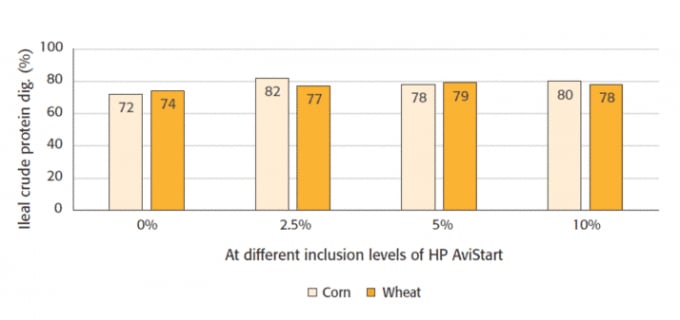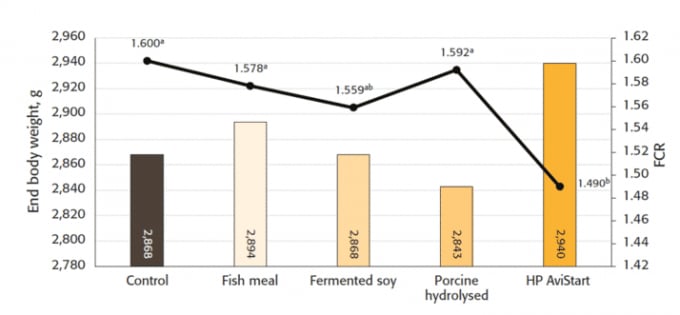May 24, 2025 | 16:22 GMT +7
May 24, 2025 | 16:22 GMT +7
Hotline: 0913.378.918
May 24, 2025 | 16:22 GMT +7
Hotline: 0913.378.918
Young chicks have an underdeveloped digestive system and at the same time have a high nutritional requirement than older broilers. Chicks grow and develop at a higher rate during the first two weeks of hatching reaching 4-4.5 times of their day old weight. Each chick doubles in weight several times as the heart, liver and digestive tract are yet to gain the necessary size to support developing muscles and bones. Precise nutrients are necessary to assure proper growth, but the ability to absorb nutrients are impaired by the chick’s underdeveloped digestive tract. As a result, the chick draws energy from the immunoglobulins and unsaturated fatty acids in its yolk sac instead of using them for growth and immunity.

To overcome the limitations of the immature digestive tract, a special feed formulation is essential where the nutrient uptake can be enhanced during the first few days of rearing to improve the overall performance right up to slaughter.
HP AviStart is a unique highly digestible protein source, that is derived from an enzymatic co-processing of soybeans and yeast. Compared to standard soy proteins, it contains a very low level of the anti-nutritional factors that limit the absorption of feed nutrients. That means that the immature gut of newly hatched chicks can easily absorb the nutrients which the product HP AviStart contains, thereby stimulating their healthy growth and development from day one.
The high digestibility of HP AviStart is primarily due to the very low content of non-protein nitrogen (NPN), which is a direct reflection of the amino acid content. Diets must be reformulated when an existing protein source such as soybean meal is replaced with HP AviStart, which has higher protein and amino acid digestibility. This will ensure the right level of protein and energy in the starter feed. In the large intestine of older birds, the gut microflora are able to stay in balance. However, in a newly hatched chick, the microflora is not yet fully established, and an influx of undigested nutrients may cause a proliferation of non-beneficial bacteria.

HP AviStart with its high digestibility is proven to boost the intestinal development of young chicks. This not only ensures a well-balanced microflora but also reflects in the overall performance of older chickens. Trial reports shows that the overall protein digestibility in diets improved when
HP AviStart was included in the diets (Figure 1).
During the 42 day long study, at Khon Kaen University, Thailand, newly hatched Cobb broilers were given a starter feed containing 5% each of fishmeal, fermented soy, porcine hydrolysed protein and HP AviStart for the first seven days of rearing. A control group received a starter diet based on corn and soybean meal. The broilers were fed an identical diet for the remaining days of the trial.
On slaughter age day 42, the broilers fed 5% HP AviStart had significantly more body weight than other trial groups and also had the lowest feed conversion ratio. The HP AviStart fed group had the best quality breast meat in terms of protein and moisture content (data not shown) and the lowest feed conversion rate (FCR) (Figure 2).
Researchers concluded that the broiler chicken producers can earn an extra 5.74 Thai baht (USD0.166) per bird (May 2017) – equivalent to a 34:1 return on investment when they are using HP AviStart in starter feed.
The specialty soy protein continues to have a beneficial effect way beyond the starter phase as confirmed by the latest trial in Thailand. The explanation for the improvement lies in the broiler villi height:crypt depth ratio which is otherwise known as the gut health indicator.
Research has shown that the ratio between villus height and crypt depth is linked to protein utilisation. A high ratio is also linked to a low FCR. This is one of the mechanisms behind the life-long carry-over effect of HP AviStart.
Some studies have shown a strong correlation between a well developed gut and improved FCR when the protein digestibility is high and the amount of undigested nutrients available to non-beneficial bacteria in the hind gut is decreased.
In broilers fed a ten-day starter diet containing corn or wheat with HP AviStart, villi height:crypt depth ratio (VH:CD) was seen to increase and was highest at a 5% inclusion rate (Figure 3).
Another study showed a significant correlation between higher VH:CD ratio and lower FCR, supposedly due to a better development of the gut. The effect of early 10 day feeding of HP AviStart compared to not feeding HP AviStart was carried over and still measured on day 60, even after the birds have transitioned to a different diet (Figure 4).
The findings from Khon Kaen University reinforce the results of a recent meta-analysis of 16 other feeding trials (2012 – 2016) from Universities, research institutes and commercial broiler producers in some ten countries, which resulted in 73 included observations.
The meta-analysis evaluated the difference between the control group, competitor products and HP AviStart group in the feeding trials. The studies had between two and six dietary treatments.
In all the trials included in the meta-analysis, the starter diets contained the same amount of digestible amino acids and the same metabolisable energy content.
A variation in amino acid and energy content among trials took place considering regional difference in recommendations and local practice. In addition, different feed evaluation systems for ME were used.
Studies were performed by external parties.
HP AviStart was added to starter feed at doses ranging from 0% to 10% and tested against a soybean meal control and starter feeds supplemented with ‘other’ high cost ingredients such as fishmeal, potato protein, corn gluten or blood plasma during the starter period.
The same diet(s) was fed until completion of the experimental period (day of slaughter) of all trials.
In the control group, soybean meal was the only protein source.
For the majority (74 %) of the trials, corn was used as only cereal; in the remaining diets both wheat and corn or wheat as only cereal were used.
In two of the trials, the starter period was 28 days out of a total 60-day experimental period.
Most trials ran for 35 to 42 days.
For the majority of the studies, the starter diet was fed as crumble and the rest was mash.
Key findings
End weight and feed conversion ratio improved when 5% and 10% HP AviStart were included in broiler starter feed, compared to the control and other more costly protein ingredients.
A significant (P< 0.05) effect of dietary treatment on end weight (slaughter) and FCR were found (Table 1). Broilers fed HP AviStart during the starter phase were found to have significantly higher end weight and lower FCR than broilers fed control diets. The broilers fed others diets were having intermediate results.
The significantly lower FCR with HP AviStart was due to a higher gain in body weight (P < 0.05) as no difference in feed intake was found (P > 0.05).
A significant (P < 0.05) difference in end weight (slaughter) and FCR at different inclusion level of HP AviStart is found (Table 2). The dose response of HP AviStart is found to be a significantly
(P < 0.05) linear response.
The meta-analysis of 16 studies concluded that HP AviStart in starter feed significantly improves broiler’s performance compared with the control and other more expensive protein ingredients. Highest end weight and lowest FCR were found at an inclusion level of 10 % HP AviStart, which was also the highest inclusion level tested. The positive effect on performance is linear in the doses tested: 0-10 % HP AviStart. Findings from all trials indicate that 5% is the best starting point for maximising returns when formulating starter feed with HP AviStart.
(Thepoultrysite)

(VAN) Alt Carbon has raised $12 million in a seed round as it plans to scale its carbon dioxide removal work in the South Asian nation.

(VAN) Attempts to bring down the price of the Japanese staple have had little effect amid a cost-of-living crisis.

(VAN) Fourth most important food crop in peril as Latin America and Caribbean suffer from slow-onset climate disaster.

(VAN) Shifting market dynamics and the noise around new legislation has propelled Trouw Nutrition’s research around early life nutrition in poultry. Today, it continues to be a key area of research.

(VAN) India is concerned about its food security and the livelihoods of its farmers if more US food imports are allowed.

(VAN) FAO's Director-General emphasises the need to work together to transform agrifood systems.

(VAN) Europe is facing its worst outbreak of foot-and-mouth since the start of the century.